英语教育硕士论文开题报告
英语专业开题报告(7篇)

英语专业开题报告(7篇)英语专业开题报告(7篇)在现在社会,我们使用报告的情况越来越多,多数报告都是在事情做完或发生后撰写的。
那么报告应该怎么写才合适呢?以下是小编为大家整理的英语专业开题报告,欢迎大家分享。
英语专业开题报告1开题报告是提高选题质量和水平的重要环节,是当学生确定毕业论文选瓜方向后,在调查研究墓础上撰写的报请学校批准的选题计划.它主要说明这个课压为何应该进行研究,自己拥有何种条件进行研究以及准备如何开展研究等问题,也可以说是对课题的论证和设计.指导教师应该认真引导学生写好开瓜报告,向学生阐述撰写开题报告的重要意义,并通过开月报告对学生的整个论文情况进行宏观的把握.那么如何指导英语专业学生写好开理报告,我将结合自己的教学实践谈谈自己的体会。
1、创新选题、合理定题进行开题报告写作的首要工作是指导学生进行选题,确切的说是进行论文方向的选择.这是正式书写开题报告前不可或缺的准备工作,是教师和学生都应该予以重视的重要环节.在这一过程中,学生会逐步对自己课月的研究方向渐渐清晰,脉络更加分明.确定论文写作方向一般有两种方式:"由面及点式"和"由点及面式".这是两种截然相反的选题思考过程.作为英语专业的学生,他们的选题方向主要有:语言学方向,翻译方向,文化方向,文学方向和教学法方向.学生可以根据自己的兴趣先选择一个大的方向,最终确立题目,这就是所谓的"由面及点式"的选题思路.例如,学生首先可以确定自己选越方向为文学,然后,在众多英美文学作品中选择自己比较熟悉和感兴趣的《简爱》,最后通过材料搜集、调查研究,找到自己的学术兴奋点,并最终确立题目《分析海伦的性格特征》。
比如说学生可以先选择《简爱》这部作品,然后确立写作方向.如果对作品语言分析,修辞特点分析,则可划分到语言学方向;如果是对其电影版本的台词翻译进行分析,那划分到了翻译方向:还可以通过这部作品分析中西方爱情观或中西方女性独立惫识,这就归为文化方向.这种"由点及面式"的选择思路往往比较适合平时学习注愈积累、善于思考的学生.这类学生在学习中往往普于发现间理和解决问瓜,具有一定的创新意识和问题意识.指导得当再加上学生自身的努力,往往会写出比较优秀的毕业论文。
英语教育硕士研究生开题报告

研究生开题报告及论文工作计划论文题目:图式理论在高中阅读教学中的应用
研究生
学院外国语学院
专业学科教育英语
研究方向基础教育
指导教师
培养类别教育硕士
填表日期二0 0八年六月
师大学研究生学院制表
填表说明
1、研究生论文写作工作,必须通过开题报告论证并经审定后方可开始。
2、本表填写三份,报学院一份,导师、研究生各留存一份。
3、研究生培养类别是指硕士研究生、同等学力硕士、高师硕士、教育硕士、博士研究生五类。
4、如页纸不够,可用A4纸加附页。
5、一律用A4纸打印、装订。
3。
英语毕业论文开题报告(范文5篇)
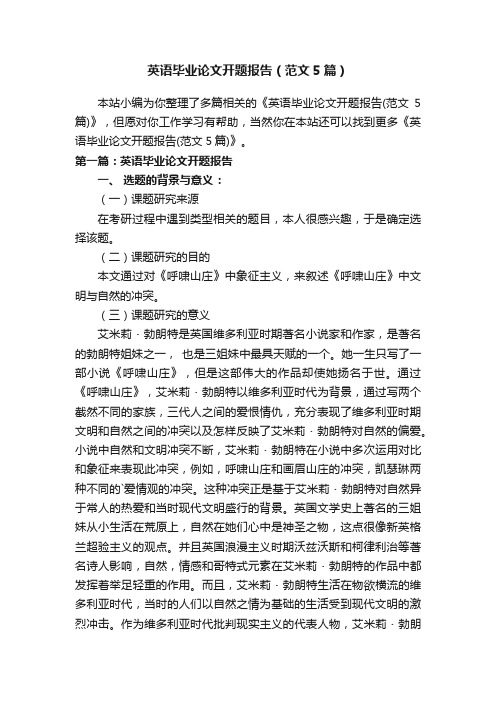
英语毕业论文开题报告(范文5篇)本站小编为你整理了多篇相关的《英语毕业论文开题报告(范文5篇)》,但愿对你工作学习有帮助,当然你在本站还可以找到更多《英语毕业论文开题报告(范文5篇)》。
第一篇:英语毕业论文开题报告一、选题的背景与意义:(一)课题研究来源在考研过程中遇到类型相关的题目,本人很感兴趣,于是确定选择该题。
(二)课题研究的目的本文通过对《呼啸山庄》中象征主义,来叙述《呼啸山庄》中文明与自然的冲突。
(三)课题研究的意义艾米莉・勃朗特是英国维多利亚时期著名小说家和作家,是著名的勃朗特姐妹之一,也是三姐妹中最具天赋的一个。
她一生只写了一部小说《呼啸山庄》,但是这部伟大的作品却使她扬名于世。
通过《呼啸山庄》,艾米莉・勃朗特以维多利亚时代为背景,通过写两个截然不同的家族,三代人之间的爱恨情仇,充分表现了维多利亚时期文明和自然之间的冲突以及怎样反映了艾米莉・勃朗特对自然的偏爱。
小说中自然和文明冲突不断,艾米莉・勃朗特在小说中多次运用对比和象征来表现此冲突,例如,呼啸山庄和画眉山庄的冲突,凯瑟琳两种不同的`爱情观的冲突。
这种冲突正是基于艾米莉・勃朗特对自然异于常人的热爱和当时现代文明盛行的背景。
英国文学史上著名的三姐妹从小生活在荒原上,自然在她们心中是神圣之物,这点很像新英格兰超验主义的观点。
并且英国浪漫主义时期沃兹沃斯和柯律利治等著名诗人影响,自然,情感和哥特式元素在艾米莉・勃朗特的作品中都发挥着举足轻重的作用。
而且,艾米莉・勃朗特生活在物欲横流的维多利亚时代,当时的人们以自然之情为基础的生活受到现代文明的激烈冲击。
作为维多利亚时代批判现实主义的代表人物,艾米莉・勃朗特看到了现代文明带来的种种罪恶,内心更加执着于对自然的喜爱。
因此,要想真正读懂这部伟大的著作,就必须要了解小说中艾米莉・勃朗特对自然和文明的观点。
只有了解艾米莉・勃朗特对自然和文明的态度,才能真正明白在这爱恨情仇下有着更深刻的寓意-人类生活应该顺应自然和本性。
英语硕士论文开题报告

英语硕士论文开题报告英语硕士论文开题报告精选引导语:在当今世界搞科学研究,必须重视开题报告的'写作。
以下是英语硕士论文开题报告精选,供大家参考。
英语硕士论文开题报告范例:题目:A Corpus-based Study on SyntacticFeatures of Business English Correspondence1 Introduction1.1 Background of the StudyChina plays a much more important role in world economic system along with thedevelopment of economic globalization. Economic globalization not only accelerates our country'seconomic growth, but also promotes the speed of international trade all over the world. Thereforeexcellent business communication competence becomes increasingly important as well. As one ofthe language media business English correspondence aims to link overseas and domestic economicentities, exchange information, communicate with each other and deal with business. It plays anextremely important role in the frequent international trade. It is no exaggeration to say, businessEnglish correspondence is used in every step of business activities.The course of business English writing has almost expanded into every university curriculum.Both foreign and domestic scholars have done researches on business English correspondencefrom the perspective of lexicon, semantic fields, especially based on corpus. There are two majorlarge-scale corpora on business English. One is Nelson's Business English Corpus (BEC for short)accounting for one million words. Theother one is Poly U Business Corpora constructed by HongKong Polytechnic University. The Poly U Business Corpora are made up of three comparablecorpora of Chinese, English and Japanese business texts, the majority of which originate from thebusiness and finance sections of newspapers written in those languages, covering news and reportsfrom auditing and accounting to insurance and investments. Each of the corpora has more than onemillion words. It is accessible on line for searching key words to see a concordance taken fromPoly U Business English corpus, which is helpful to students and teachers. It is thus obviously thatbusiness English is quite important so that attracts much attention from linguistic researchers. Ithas been an overriding aim of this project to create a resource for researchers to help furtherknowledge of an area which so far has been the research topic of many scholars.1.2 Significance of the StudyThis thesis makes a relatively complete study of business English correspondence from theperspective of lexical grammar theory and syntactic theory. It takes up business Englishcorrespondence as its research topic and aims to propose some feasible strategies in businessEnglish correspondence writing and teaching. The study expected to achieve both theoretical andpractical significance as follows:First of all, this study will introduce a new research method. Corpus provides a brand newway for the study of language. It breaks through the traditional method of intuitive experiencemethod and turns to the original analysis of natural language in order to provide a firm foundationand data support for language research in various fields. Traditional intuitive experience methodfocuses on personal experience and intuition,manual methods or introspective method whichcould acquire linguistic knowledge only from limited data of language materials. This method ofacquiring linguistic knowledge is not only inefficiency but also more subjective which inevitablyleads a effect on the accuracy of final result. However, corpus-based approach is totally different.Corpus can find the target data quickly by using computer software for scientific analysis, andovercome the limitation of traditional research on the subjectivity and one-sidedness. Thismacroscopic method can carry on a multi-level and all-rounded research on the basis of a largenumber of real data, and effectively promote the new theoretical model and research paradigm. Italso relies on computer science to achieve its powerful function in language searching, andprovides a new method in linguistic research for the majority of language researchers.Secondly, a clear understanding of lexical grammar theory could be achieved. Language is atool for human communication which inevitably cannot do without meaning expression andunderstanding. Sinclair broke the previous rules of describing vocabulary and grammar in aseparate way. Therefore, a new point of view has been proposed. That is language should bedescribed by using the way combining vocabulary and grammar which opened up a new path forlanguage description based on a corpus. Then he proposed lexical grammar, and believed thatvocabulary and grammar are equally important, in which vocabulary is the starting point forbuilding the language model. The key aspects about the origin of lexical grammar and thewholeness of lexis and grammar will be discussed in detail in next chapter and this study is basedon the theory of lexical grammar to explore the features of business Englishcorrespondence fromlexical and syntactic levels.Thirdly, after a relatively complete study on the business English correspondence, typicallexical and syntactic features could be worked out.Fourthly, feasible strategies could be proposed to business English correspondence writingand teaching.1.3 Layout of the ThesisIn this thesis, the study will do some research on business English correspondence andmanage to summarize some common syntactic features of business English correspondence basedon lexical-grammar theory and syntactic theory. This thesis is divided into the following six parts:Chapter 1, the introduction part is an introduction concerning the theme of the thesis,including a general introduction of the background and significance of the study and theorganization of the whole thesis.Chapter 2, a literature review is provided in this chapter, which gives out an overview of thecorpus linguistics and business English correspondence. It first introduces business Englishcorrespondence and corpus linguistics briefly, and then gives a comprehensive introduction tothem which are also discussed here for better understanding to the field that the theory will beapplied to. Relevant studies both on Corpus linguistics and business English correspondence arealso presented at the end of each part.Chapter 3 introduces the theoretical framework which contains four main parts: principles ofbusiness English correspondence, the application in corpus linguistics, lexical grammar andsyntactic theory. Then Sinclair's lexical grammar theory and syntactic theory will be discussed indetail. In the endof this chapter, the writer will talk about the paper's feasibility.Chapter 4 addresses the research methodology of the study which includes the corpus-basedquantitative and qualitative method, the corpus and instruments used in the study, the proceduresof the study both in relation to data collection and data processing and concordance.Chapter 5 is the main part of the thesis of which lexical and syntactic features will bediscussed and analyzed in this part. Word length, sentence length, wordlist and some other wordfrequency will be listed and analyzed in detail.Chapter 6 draws a conclusion of the thesis, which gives a summary to the whole paper.Besides the major findings of the study, it also points out the limitations and difficulties of thepresent study.2 CONTENTSAbstract in ChineseAbstract in English1 Introduction1.1 Background of the Study1.2 Significance of the Study1.3 Layout of the Thesis2 Literature Review2.1 Studies on Business English Correspondence Abroad and at Home2.2 Studies based on Corpus Linguistics Abroad and at Home2.3 Summary3 Theoretical Framework3.1 Writing Principles of Business English Correspondence3.2 Lexical Grammar3.3 Syntactic Theory4 Methodology4.1 Corpus-Based Approach4.2 Research Instruments4.3 Research Procedures4.3.1 Data Collection4.3.2 Data Clean-up4.3.3 Tokenization4.3.4 Lemmatization4.3.5 Part-of-speech Tagging5 Results and Discussions5.1 Syntactic Complexity Analysis5.1.1 Analysis of Word Length and Sentence Length5.1.2 Contrastive Analysis between Content Words and Function Words5.1.3 Contrastive Analysis between Simple Sentence and Complex Sentence5.2 Syntactic Pattern Analysis5.2.1 Passive Voice5.2.2 Interrogative Sentence5.2.3 Subjunctive Mood5.3 Syntactic Feature Analysis5.3.1 Syntactic Feature of Letters of Request and Comfirmation5.3.2 Syntactic Feature of Letters of Acceptance and Refusal5.3.3 Syntactic Feature of Letters of Appreciation and Apology6 Conclusion6.1 Major Findings6.2 Implications for the Study6.3 LimitationsAcknowledgementReferencesAppendixPapers published in the period of Ph. M. education3 进度安排1.Collecting the related materials and designing theresearch, data analysis: Sep.1st-Dec.31st,20XX2.Writing the first draft: Jan.1st- Feb.31st, 20XX3.Writing the second draft:Mar. 1st- Apr. 31st,20XX4.Writing the final draft: May. 1st- May.31st,20XX5.Preparing for defense of the thesis: June.1st- June31st,20XX4 References[1] Dudley-Evans,T. and St John,M.J. (1998)。
最新[英语学习]教育硕士开题报告
![最新[英语学习]教育硕士开题报告](https://img.taocdn.com/s3/m/cacd9062551810a6f4248649.png)
[英语学习]教育硕士开题报告攻读(博士/硕士/课程高级课程)的研究生封面(试卷/作业)(在2010-2011学年的第二学期),该学术论文的标题和主题由张润撰写,其名称是专业课的教学。
英语入学的那一年是2010年1月。
一个简短的评论是:老师的签名:第一章引言1.1.研究的背景随着“信息革命”浪潮的兴起和发展,文化、科技以前所未有的广度和速度传播。
人们通过什么方式传播科学知识和最新信息?首先是写作,尤其是英语写作。
专家、学者、教授、记者,通常提前写好、新闻稿,然后通过媒体传播。
可以看出,现代视听工具的广泛使用不仅没有降低写作的地位,而且对写作提出了更高的要求。
英语写作已经成为不同国家和人民之间交流的重要手段。
从语言学习的角度来看,“英语学习成功的标准不是学生记住多少单词、短语和句型,他们知道多少语法规则,而是他们是否能创造性地用他们所学的语言来表达,也就是说,他们在吸收、分析、综合、判断、重构和再创造的基础上,不仅能识别而且能把他们所学的语言同化为他们所学的语言。
(刘,199组织材料;规划文章结构;列出大纲;起草条款;组织语言;用词造句;修改文章;标点符号和字母大小写的正确使用。
(3)写作技能教学过程的三个阶段:写作前的活动,写作中的活动和写作后的活动。
(4)选材:相当于学生水平;贴近学生生活;主题明确,目的明确。
它既有趣又真实。
(5)教师角色:指导、灵感、示范、讨论、鼓励、评论。
建议的教学思路与“过程体裁法”倡导的训练过程基本一致,改变了简单的写作技巧,将写作的所有要素结合在一起(语言知识、语境知识、写作目的和写作手段)。
“过程体裁法”强调整个写作过程是思考、发现的过程。
这个过程不仅涉及语言知识、各种学习策略的使用、积极的情感体验,更重要的是交际能力所要求的文化交流。
过程体裁法强调交际目的决定体裁的存在,强调体裁的规律性和制约性。
体裁是语言使用者共同遵守的一种程式化的社交工具。
因此,“过程体裁教学法”被越来越多的教师应用于写作教学。
教育硕士开题报告英文

教育硕士开题报告英文IntroductionEducation plays a crucial role in shaping the future of individuals, societies, and nations. As a result, the pursuit of advanced degrees in education, such as a Master's in Education, has become increasingly popular. This report aims to provide a comprehensive overview of the proposed research study for the Education Master's thesis.BackgroundTraditional teaching methods often fail to capture the attention and engage students effectively in the learning process. With the advancement of technology, schools have seen a shift towards integrating digital tools and resources into the classroom environment. This digital transformation has brought forth several benefits, including improved student engagement and enhanced learning outcomes. However, it is essential to evaluate the impact and effectiveness of these digital tools on education comprehensively.Research ProblemThe primary focus of this study is to investigate the impact of integrating digital tools, specifically interactive multimedia, in primary classrooms. The goal is to assess the effectiveness of these tools in enhancing student engagement, developing critical thinking skills, and improving academic performance. It is essential to understand the challenges and opportunities associatedwith implementing these digital tools to inform pedagogical practices and ensure successful integration into the classroom. Research Questions1. What is the impact of interactive multimedia tools on student engagement in primary classrooms?2. How do interactive multimedia tools contribute to the development of critical thinking skills in primary students?3. Do interactive multimedia tools improve academic performance in primary students?4. What challenges and opportunities arise from the implementation of interactive multimedia tools in primary classrooms?Research Objectives1. To evaluate the impact of interactive multimedia tools on student engagement in primary classrooms.2. To assess the contribution of interactive multimedia tools to the development of critical thinking skills.3. To examine the correlation between the use of interactive multimedia tools and academic performance in primary students.4. To identify the challenges and opportunities associated with implementing interactive multimedia tools in primary classrooms. Research MethodologyTo accomplish the research objectives, a mixed-methods approach will be employed. The study will involve both quantitative andqualitative data collection and analysis. Questionnaires will be administered to primary school teachers and students to measure student engagement, critical thinking skills, and academic performance. Additionally, interviews and focus groups will be conducted to gather qualitative data on the challenges and opportunities regarding the implementation of interactive multimedia tools in classrooms.Expected OutcomesBased on the analysis of the collected data, this study aims to provide insights into the effectiveness of integrating interactive multimedia tools in primary classrooms. It is anticipated that the research will demonstrate a positive impact on student engagement, critical thinking skills, and academic performance. Additionally, the study will identify potential challenges and opportunities to aid educators in effectively implementing these tools in their teaching practices.ConclusionWith the increasing prevalence of technology in education, it is crucial to evaluate the impact of digital tools, such as interactive multimedia, on primary students' educational experiences. Through this research, we hope to contribute to the knowledge base surrounding the integration of digital tools in classrooms and inform educators about the potential benefits and challenges associated with their implementation.。
英语专业开题报告范文英语硕士论文开题报告例文
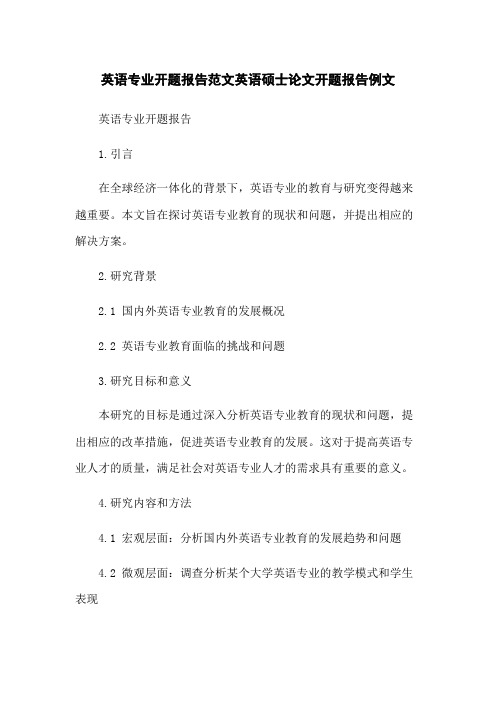
英语专业开题报告范文英语硕士论文开题报告例文英语专业开题报告1.引言在全球经济一体化的背景下,英语专业的教育与研究变得越来越重要。
本文旨在探讨英语专业教育的现状和问题,并提出相应的解决方案。
2.研究背景2.1 国内外英语专业教育的发展概况2.2 英语专业教育面临的挑战和问题3.研究目标和意义本研究的目标是通过深入分析英语专业教育的现状和问题,提出相应的改革措施,促进英语专业教育的发展。
这对于提高英语专业人才的质量,满足社会对英语专业人才的需求具有重要的意义。
4.研究内容和方法4.1 宏观层面:分析国内外英语专业教育的发展趋势和问题4.2 微观层面:调查分析某个大学英语专业的教学模式和学生表现4.3 研究方法:文献综述、问卷调查、访谈等5.研究计划5.1 第一阶段:收集相关文献,了解国内外英语专业教育的发展情况5.2 第二阶段:设计问卷和访谈提纲,进行数据收集5.3 第三阶段:对数据进行整理和分析,撰写研究报告5.4 第四阶段:根据研究结果提出改革方案6.预期结果和讨论预计通过本研究可以得出以下结论:6.1 英语专业教育存在的问题和不足6.2 针对问题和不足的改革措施6.3 改革措施的可行性和有效性讨论7.参考文献所有在文中引用的参考文献。
附件:1.调查问卷(具体内容见附件一)2.访谈提纲(具体内容见附件二)法律名词及注释:1.《中华人民共和国教育法》:指中华人民共和国国家立法机关通过的,为规范教育活动、维护教育秩序、保障教育权利义务等而制定的法律。
2.《大学生诚信教育管理办法》:指为加强大学生诚信教育,培养大学生的诚实守信、法纪意识和道德修养,维护高等学校教育教学秩序和社会公平正义,规范高等学校大学生诚信教育管理活动而制定的管理办法。
英语专业论文开题报告范文精选5篇

英语专业论文开题报告范文精选5篇开题报告是指开题者对科研课题的一种文字说明材料。
这是一种新的应用写作文体,这种文字体裁是随着现代科学研究活动计划性的增强和科研选题程序化管理的需要而产生的。
开题报告要怎么写呢?小编精选了一些关于开题报告的优秀范例,一起来看看吧。
英语专业论文开题报告1,研究来源及其意义:长期以来,由于多年根深蒂固的传统的教授语言的方法束缚,高中英语阅读教学在很大程度上仍脱离了培养阅读能力这一主要任务,成了专为应试服务的逐句翻译和烦琐的语法分析.其现状主要表现为:阅读课过分重视语法和词汇知识的讲解,而忽视对学生实际语言运用能力的培养;重教师的导向,而轻学生的主体性和人文精神的培养.其结果是,不仅忽略了课堂提问在阅读教学中的促进作用,学生在课堂上囫囵吞枣,死记硬背,简单地模仿句型,而且学生普遍存在对整篇文章的综合理解,阅读速度慢,缺乏分析问题,解决问题的能力以及积极参与阅读教学的兴趣,阅读课堂呈现单调乏味的现象.这种现状已经阻碍了阅读教学的进一步发展.根据新课标的精神,高中阶段英语教学的目的是初中英语教学的基础上发展听,说,读,写的基本技能;侧重培养阅读能力且新编的人教版高中英语教科书以阅读课为中心,突出了高中阶段阅读教学的中心地位,体现了高中阶段英语教学侧重培养阅读能力的原则.有此可见,英语阅读教学作为高中英语教学的侧重点,其目的不仅是要让学生学会语言知识,获取文章提供的信息,领悟文章的内涵,更重要的是使学生掌握阅读的方法和技能,逐步培养语言学习能力.而课堂提问则关系到英语阅读教学的质量,是阅读教学过程得以顺利进行的关键.课堂体温,是一种教学活动过程.通常是教师提出问题,引导学生运用已经学过的知识,回答教师提出的问题,提高分析能力,从而获得新知识的方法,是阅读课堂教学中使用频率的一种教学手段.这也正是顺应了新课标中所倡导的那样,在阅读教学中注重素质教育,鼓励学生积极参与教学活动,通过感知,体验,实践,参与和合作探究等活动方式,来完成阅读教学的任务和实现英语阅读教学目标.同时,通过课堂提问在阅读教学中的运用,也充分体现了阅读教学以学生为中心的教学思路,突出学生主体,尊重个体差异的基本理念.据此,为改变传统阅读教学的模式,我们在进行阅读课堂教学时,在阅读前教师可以提出一系列问题,让学生带着问题有目的地去阅读能激发他们的好奇心和求知欲,提高他们的阅读能力.sefc教材所提供的文章内容广泛,体裁丰富,其中以叙述和论证体为主,教师应根据不同的文体设计不同的问题,体现出不同体裁的特点.教师还应把课堂作为学生英语实践活动的舞台,把课文内容作为话题,组织学生进行讨论,议论,评价,延伸和借鉴等言语实践活动,从而发挥学生在阅读教学中的主体作用,培养其积极的思维能力和创造能力.而且,国外一些语言学家早在20世纪60年代初就从不同角度探讨研究第二语言的阅读过程,创立和丰富了外语阅读教学理论.语言学家卢利亚认为:复杂的阅读理解至少有三个环节组成区分单词的确切意义;把握词与词之间的句法关系以及由词组成的复杂的结构.他的话指出了阅读理解过程中语言知识的重要性.1967年goodman借助心理语言学的观点,提出了崭新的阅读理论,他认为阅读是一个复杂的心理语言活动过程,是作者,语言信息,和读者三方面共同作用的结果.随着心理学,心理语言学,应用语言学和篇章语言学研究的发展,人们对阅读理论的探讨不断深入.20世纪80年代初,carrol等人提出了现代图式理论.它强调了读者的文化背景知识在阅读理解过程中所起的作用.目前,在国内对英语阅读教学的研究,人们有着各自不同的看法.尤其是在阅读教学模式方面,则主要存在着两种不同的意见:一种是自下而上的模式,认为阅读教学的基本路子是先教单词,再讲句子,ZUI后扩展到全文.另一种是自上而下的模式,强调reading is a psycholingual guessing game此外,国内的阅读教学理论也认为,阅读过程是一个主动的,有目的的,有创造性的心理过程.倡导教师在阅读教学中应该使学生始终处于积极主动的状态,通过对整篇文章的整体把握来获取文章信息,掌握语言知识,培养其阅读能力.随着国内外对阅读教学过程的不断深入,阅读教学在英语教学中的重要性将会变得显著突出.如何在阅读教学中激发学生的学习兴趣,如何使其能创造性地解决课文话题所引出的与现实生活密切相关的问题,从而提高学生的阅读水平,由应试向素质教育转变,将成为一个备受注目的亟待解决的大问题.本课题拟在外语教学法的范畴内,通过探讨如何运用课堂提问技巧,一方面为学生能够根据问题更快,更准确地把握对文章的综合理解,更好地获取文章的内在信息起到了积极的促进作用,另一方面,由于本课题的内容在目前的英语阅读教学中出现很少,而本课题的研究将弥补这一方面的不足,也为广大教师在阅读教学中所采用的教学技巧提供了一项参考.它的理论意义和实践意义将会十分显著.2,研究目标:针对课文内容的不同,在阅读课堂教学的各环节中精心设计问题,为引导学生能够积极参与阅读教学,使其能够带着疑问对文章进行阅读,并向学生提供尽可能多的直接使用语言的机会,让学生回答问题,分析问题或就某一问题进行讨论,帮助学生在有限的课堂中限度地获取文章的内在信息,提高其阅读速度,分析问题和解决问题的能力,从而改善阅读课堂教学的质量.3,研究的内容:主要探讨如何在阅读课堂教学的各个环节中设计课堂提问来吸引学生的阅读兴趣,尽可能地引导学生变被动为主动,积极参与阅读教学,在活跃的课堂教学环境中提高学生的阅读能力.本课题研究主要解决以下几个问题:(1),对阅读课堂教学的现状进行分析,提出通过精心设计课堂提问来改善阅读教学的必要性.(2),根据阅读教学过程中的实际情况,探索和总结适合于阅读教学的课堂提问的技巧特征.(3),总结和探索在阅读课堂教学中适当运用课堂提问的技巧能否有利于优化阅读课堂教学的各环节.4,研究的方法和手段:(1),方法:调查法,归纳总结法,例证法,教学观摩法,查阅文献资料法.(2),课题的研究手段主要是以实际应用为主,兼以完善这一理论研究.5,研究的进度安排:统一按照院系领导和指导老师的安排,并结合论文写作的实际情况,认真完成论文协作的每项步骤.参考文献:1. 程晓堂,郑敏.英语学习策略[m]. 上海: 外语教育与研究出版社,XX2. 桂诗春.新编心理语言学[m]. 上海: 上海外语教育出版社,XX3. 胡春洞,王才仁.英语阅读论[m]. 南宁: 广西教育出版社,19984. 束定芳,庄智象.现代外语教学---理论,实践与方法[m]. 上海: 上海外语教育出版社,1996年10月第1版5. 施建萍.高中英语阅读教学中的五种问题设计[j].中小学英语教学与研究,XX(2): 41.6. 迟克晓.设计创新问题优化教学环节培养创新思维[j].广西教育学院学报,XX(7): 128.7. 沈正南.高中开放式课堂教学初探[j].中小学外语教学,XX(4): 11.8.何文琴.高中英语课堂提问艺术初探[j].中小学英语教学与研究,XX(2):18.9.杨李花.高中英语阅读教学中的问题设计[j].天津教育,XX(11): 54.10.范煜华.精心设计课堂问题提高课堂教学效率[j].中小学外语教学,XX(6): 22.11.余冰清,谢建珍.充分利用新教材培养学生阅读能力[j].中小学外语教学,XX(6): 21.12.孙曼丽.高中阅读课导入与小结的创新教学设计[j].中小学外语教学,XX(9): 21.13. 周春敏.谈谈高中英语任务型课堂教学设计[j].中小学英语教学与研究,XX(5): 20.14. 林松青.创设教学活动情境培养学生创造个性[j].基础教育外语教学研究,XX(9): 56.15. 葛文山,朱俊爽.浅谈课文教学中问题的设置[j].中小学外语教学,XX(3): 6.16. 朱惠芳.研读《英语课程标准》调整阅读教学策略[j].中小学英语教学与研究,XX(9): 24.17. 杜星.讨论式教学在sefc教材中的运用[j],中小学英语教学与研究,XX(3):13.18. 鲁芬芬.高中英语阅读课教法探讨[j],中小学外语教学,XX(11): 17.英语专业论文开题报告题目:A Brief Analysis of the Significance of Optimism in Pollyanna研究目的和意义:拉伯雷曾经说过:生活是一面镜子,你对它笑,它就对你笑;你对它哭,它就对你哭。
英语论文开题报告参考最新3篇

英语论文开题报告参考最新3篇英语课题开题报告篇一一、课题提出的背景:随着新课改的不断深入,对小学英语教学也提出了新的挑战。
英语新课标要求教师积极探索并采取有效的学习方式,小组合作学习便是其中的一种,许多老师都运用在自己的课堂教学中,取得了显著的成效。
但由于受到一些因素的制约,比如班额大成员的,经常顾此失彼,部分合作学习习惯不好,最终造成合作学习流于形式,合作学习的有效性大打折扣。
英语新课标要求教师避免采取传授语言知识的教学方法,提倡任务型教学途径和小组合作学习。
作为当代主流的“小组合作学习”,不仅仅是一种学习方式,更是学会如何与他人互相交流合作,例如学会模仿、倾听、尊重等等,从而培养学生良好的学习习惯和团结互助的精神。
课题提出的意义:《语文课程标准》在“课程性质和地位”中明确指出:“语文是重要的交际工具,是人类文化的组成部分。
工具性与人文性统一,是语文课程的基本特点。
”“语文课程应致力于学生语文素养的形成与发展。
语文素养是学生学会其他课程的基础,也是学生全面发展和终身发展的基础”。
口头语言作为最基本、最便捷的交际工具,担负起个人社会交际的重任。
因此,作为培养未来社会人才语言素质的小学语文教学,应该重视培养学生的口语交际能力。
二、课题研究设计研究目标与预期目标通过本课题的研究,形成一整套提高学生合作学习有效的方法和策略,并在实践中提高小组合作学习的有效性。
首先建立结构合理、互帮互助的合作小组,即科学合理的分组,包括固定分组和动态分组。
再次,明确小组分工,培养独立思考、认真倾听、有序表达、积极参与与合作的习惯,接着,科学选择小组合作学习的内容,拓展创新任务,进行方式多样的科学评价。
从而培养学生的创新精神与合作意识,形成良好的心理品质,促进学生个体的发展。
研究内容和方法研究内容:小学英语课堂教学中合作学习低效情况、低效成因、的调查研究;小学英语课堂研究方法:1、文献资料研究法:整理收集小组合作学习的文献资料,和相关老师进行沟通、交流学习,梳理有利于本课题的研究理论资料。
英语硕士毕业论文开题报告
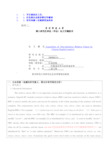
导师姓名、职称
学院(教学部)外语学院
专业外国语言学与应用语言学
研究方向二语习得
贵州师范大学研究生处培养管理科制表
一、立论依据(选题的研究意义、国内外研究现状分析)
一、研究意义
1.1 Research Orientation
The relative clause (RC) is an important construction in English and functions as attributive in a sentence. English RC includes restrictive relative clause (RRC) and non-restrictive relative clause (NRC). RRC is used to modify the noun, and can not be omitted, or the whole meaning of the sentence will not be complete. The conjunctionswhich, that, who, whom, whose, why, where, when,are used to introduce English RRCs. For example,(1)I picked up two towels that were lying on the floor.(2)John gave acheck to the farmer whose cows Bill stole. The RRC in example (1) is introduced bythat and is used to modify “towels” , and the RRC in example (2) is introduced bywhose, and is used to modify “farmer”. NRC merely offers the additional information to the noun it modifies, or to the whole sentence. NRC is often set off by commas, and the clausecan not(已经说过很多次学术论文中不能用省写形式!!!)be introduced by “that” or “a zero relative pronoun”. Moreover, NRCs are introduced bywhich, as, who, whom, whose, where, when. Sometimes the guide wordwhichrefers to the contents of the main clause.For example,(3)He did not remember hisfather, who died when he was three years old.(4)It was raining hard , which kept us indoors. In example (3) the NRC is introduced bywhoto modify “farmer”, but this NRC just add the additional information to the main clause, hence it can be omitted. “Which” in the NRC in example (4) refers to the meaning of “It was raining hard” and the NRCis also canbe omitted as in example (3).
英语教育硕士开题报告
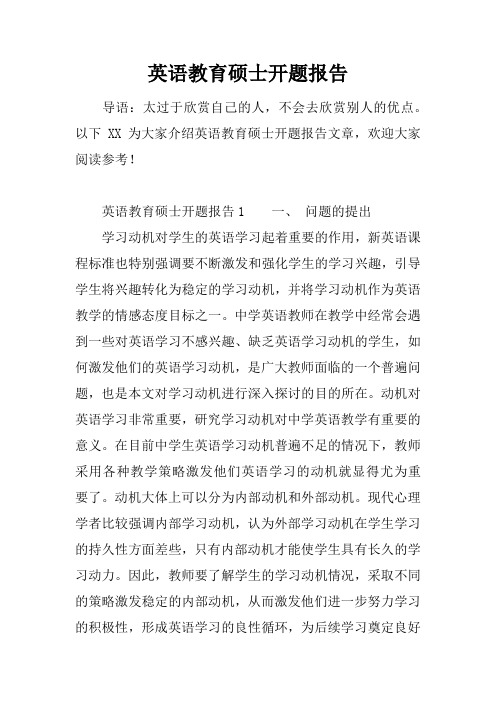
英语教育硕士开题报告导语:太过于欣赏自己的人,不会去欣赏别人的优点。
以下XX为大家介绍英语教育硕士开题报告文章,欢迎大家阅读参考!英语教育硕士开题报告1 一、问题的提出学习动机对学生的英语学习起着重要的作用,新英语课程标准也特别强调要不断激发和强化学生的学习兴趣,引导学生将兴趣转化为稳定的学习动机,并将学习动机作为英语教学的情感态度目标之一。
中学英语教师在教学中经常会遇到一些对英语学习不感兴趣、缺乏英语学习动机的学生,如何激发他们的英语学习动机,是广大教师面临的一个普遍问题,也是本文对学习动机进行深入探讨的目的所在。
动机对英语学习非常重要,研究学习动机对中学英语教学有重要的意义。
在目前中学生英语学习动机普遍不足的情况下,教师采用各种教学策略激发他们英语学习的动机就显得尤为重要了。
动机大体上可以分为内部动机和外部动机。
现代心理学者比较强调内部学习动机,认为外部学习动机在学生学习的持久性方面差些,只有内部动机才能使学生具有长久的学习动力。
因此,教师要了解学生的学习动机情况,采取不同的策略激发稳定的内部动机,从而激发他们进一步努力学习的积极性,形成英语学习的良性循环,为后续学习奠定良好的基础。
二、课题来源和理论依据1、班杜拉的自我效能感理论自我效能感是班杜拉于1977年首次提出的一个概念。
自我效能理论的核心思想是:个体的自我效能感决定他在成就情境中的行为动机。
高度的自我效能感使个体积极从事相应的活动,并乐于付出努力和采取策略来应付遇到的问题,解决面临的困难。
相反,自我效能感低的个体行为的积极性不高,为了避免失败及消极情绪的困扰,常常选择较低难度的任务、甚至自我放弃,这必然导致活动结果不尽如人意,反过来进一步降低了他的效能感。
国内外已有不少研究表明自我效能与学业成绩呈正相关。
2、韦纳的成败归因理论成败归因理论是美国心理学家伯纳德韦纳提出的。
他认为,个人对成败的解释不外乎以下四种因素:能力、努力、任务难度和机遇或运气。
英语专业论文开题报告范文精选5篇

英语专业论文开题报告范文精选5篇开题报告是指开题者对科研课题的一种文字说明材料。
这是一种新的应用写作文体,这种文字体裁是随着现代科学研究活动计划性的增强和科研选题程序化管理的需要而产生的。
开题报告要怎么写呢?精选了一些关于开题报告的优秀范例,吧。
英语专业论文开题报告imism in Poion and appion of descriptive transion studiesroductionthe intention of this study is to expages of descriptive transion studies as in its appion in transion practice and transion anah century, transion studies graduahe marginaatus arriage Refed in Emma 简?奥斯丁婚姻观在《爱玛》中的体现en, en, en, en, Jane. Emma [M]. Ne]. 爱玛. tr. 孙致礼. 南京: 译林出版社, xx.Craik, ]. heir Methods [M]. D, xx.蔡威. 《爱玛》的女性意识解读[J]. 三门峡职业技术学院学报, xx(2): 68-70.陈艳玲﹠刘利坤. 奥斯丁小说中的女性意识[J]. 黑龙江社会科学, xx(3): 107-108.邓军. 论简?奥斯汀《爱玛》中的女性婚姻观及其成因[J]. 湖北经济学院学报(人文社会科学版), xx(6): 118-119.卢爱芝,于复选. 从《爱玛》看简?奥斯汀小说中的灰姑娘主题[J].莱阳农学院学报(社会科学版), xx(3): 58-61.苏世芬. 19世纪英国女性的代言人[J]. 南京林业大学学报, xx(3): 45-47.王红丽. 爱玛形象的女性意识解读[J]. 河南商业高等专科学校学报, xx(3): 123- 125.朱虹. 奥斯丁研究[M]. 北京: 中国文联出版公司, xx.2. 毕业设计任务要研究或解决的问题和拟采用的方法:在本篇论文中,作者将结合英国当时的社会形态和背景,联系小说的情节并列举相关人物的实例,从社会阶级、女性意识、简?奥斯汀的价值观这三个方面出发,深层次的剖析和研究简?奥斯汀的婚姻观在小说《爱玛》中的体现。
英语教育硕士论文开题报告PPT
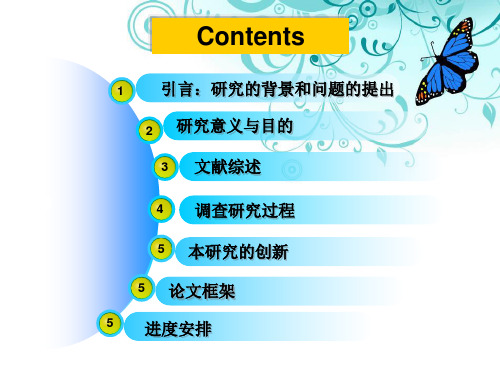
BACK
3.2 高中生英语自主学习
的理论基础
4 调查研究过程
4.1 调查目的
4.2 研究问题
4.3 调查对象与教材 4.4 研究方法、工具及数据收集
5 本研究的创新
创新点
实证研究自主 学习理论同实 际的高中英语 教学相结合
英语自主学习 的教学模式
1引言
1.1研究背景
论
1.2 研究意义与目的
1.3 论文结构
2011年10月--12月 撰写论文初稿
2012年1月---2月 在导师的指导下对初稿进行修改校正
2012年3月
最后定稿
谢谢各位老师, 希望得到您的指导和帮助!
3.3 调查对象与教材 3.4 研究方法、工具及数据收集
4数据的整理分析 5 研究结果
5.1确立高中学生英语自主学习学生的主体和教师的主导地位 5.2加强高中学生英语自主学习的学法指导和策略的培养 5.3 启示 6. 结束语 参考文献 致谢
写作计划
2011年4月---5月 2011年6月—-9月 查阅、收集相关书籍和资料 对收集的图示和资料进行整理
Contents
1 2 3 4 5 5 5
引言:研究的背景和问题的提出 研究意义与目的
文献综述
调查研究过程 本研究的创新 论文框架
进度安排
一、研究背景及意义
教育改革 和素质教 育的需要
1.1研究背景
《英语新 课程标准 》的要求
《山东省普通中小学管理基本规范》 强力推行
1.2 问题的提出
“新政”
高考压力、
“能够确定自己目标并创造学习机会的学习者,可以说,是自主学习者” ( Nunaa ) Cotterall、 Huttunen、 Dickinson、 Sheerin
英语专业论文开题报告
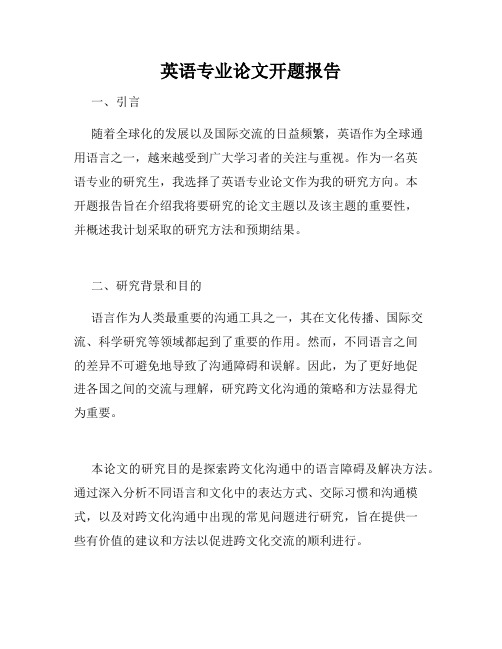
英语专业论文开题报告一、引言随着全球化的发展以及国际交流的日益频繁,英语作为全球通用语言之一,越来越受到广大学习者的关注与重视。
作为一名英语专业的研究生,我选择了英语专业论文作为我的研究方向。
本开题报告旨在介绍我将要研究的论文主题以及该主题的重要性,并概述我计划采取的研究方法和预期结果。
二、研究背景和目的语言作为人类最重要的沟通工具之一,其在文化传播、国际交流、科学研究等领域都起到了重要的作用。
然而,不同语言之间的差异不可避免地导致了沟通障碍和误解。
因此,为了更好地促进各国之间的交流与理解,研究跨文化沟通的策略和方法显得尤为重要。
本论文的研究目的是探索跨文化沟通中的语言障碍及解决方法。
通过深入分析不同语言和文化中的表达方式、交际习惯和沟通模式,以及对跨文化沟通中出现的常见问题进行研究,旨在提供一些有价值的建议和方法以促进跨文化交流的顺利进行。
三、研究问题与研究方法1. 研究问题本论文将以以下三个问题为研究核心:A. 跨文化沟通中的主要障碍是什么?B. 不同语言和文化差异如何影响人们的交流?C. 如何采用适当的策略和方法解决跨文化沟通中的障碍?2. 研究方法为了回答上述问题,本论文将采取以下研究方法:A. 文献综述:通过阅读相关的学术期刊、著作和研究报告,了解已有的研究成果和理论框架,为本研究提供理论基础和参考依据。
B. 实地调查:通过设计问卷和访谈,收集来自不同语言和文化背景的参与者的意见和经验,以了解他们在跨文化沟通中遇到的困难和解决方法。
C. 数据分析:通过对收集到的数据进行统计分析和质性分析,找出跨文化沟通中的主要障碍,并提出相应的解决方法。
四、预期结果和意义通过以上研究方法,我预计将得出以下结果:A. 确定跨文化沟通中的主要障碍,如语言差异、文化差异等,并深入分析其产生原因。
B. 发现不同语言和文化背景下的人们在跨文化沟通中常见的困难,如误解、歧视等,并提出相应的解决方法。
C. 提供具体可行的策略和方法,以促进跨文化交流的顺利进行,降低沟通障碍和误解的发生率。
英语论文开题报告(精选6篇)
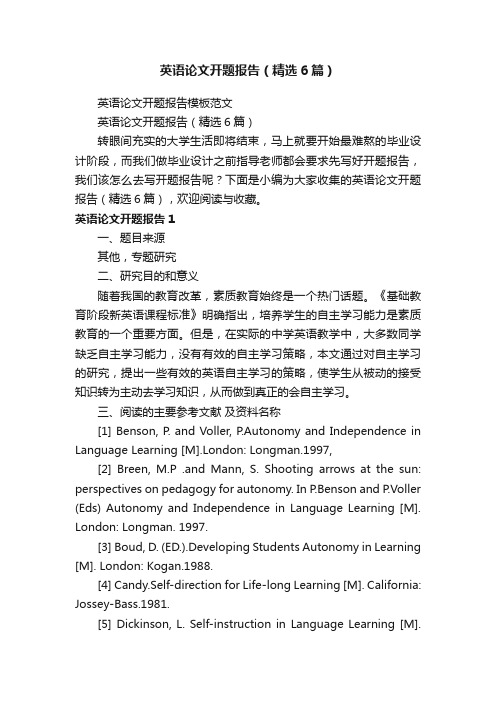
英语论文开题报告(精选6篇)英语论文开题报告模板范文英语论文开题报告(精选6篇)转眼间充实的大学生活即将结束,马上就要开始最难熬的毕业设计阶段,而我们做毕业设计之前指导老师都会要求先写好开题报告,我们该怎么去写开题报告呢?下面是小编为大家收集的英语论文开题报告(精选6篇),欢迎阅读与收藏。
英语论文开题报告1一、题目来源其他,专题研究二、研究目的和意义随着我国的教育改革,素质教育始终是一个热门话题。
《基础教育阶段新英语课程标准》明确指出,培养学生的自主学习能力是素质教育的一个重要方面。
但是,在实际的中学英语教学中,大多数同学缺乏自主学习能力,没有有效的自主学习策略,本文通过对自主学习的研究,提出一些有效的英语自主学习的策略,使学生从被动的接受知识转为主动去学习知识,从而做到真正的会自主学习。
三、阅读的主要参考文献及资料名称[1] Benson, P. and Voller, P.Autonomy and Independence in Language Learning [M].London: Longman.1997,[2] Breen, M.P .and Mann, S. Shooting arrows at the sun: perspectives on pedagogy for autonomy. In P.Benson and P.Voller (Eds) Autonomy and Independence in Language Learning [M]. London: Longman. 1997.[3] Boud, D. (ED.).Developing Students Autonomy in Learning [M]. London: Kogan.1988.[4] Candy.Self-direction for Life-long Learning [M]. California: Jossey-Bass.1981.[5] Dickinson, L. Self-instruction in Language Learning [M].Cambridge: Cambridge University Press.1987.[6] Gardner and Miller. (Eds.).Tasks for Independent Language Learning [M].Alexandria. 1996.[7] Holec, H. Autonomy and Foreign Language Learning [M], Oxford: Pergamon.1981.[8] Jones.Strategic teaching and learning: cognitive instruction in the content areas [M]. Alexandria, VA: Association of Supervision and Curriculum Development.1987.[9] Nunan, D. ‘Designing and adapting materials to encourage learner autonomy’. In P.Benson&P.Voller (eds) Autonomy and Independence in Language Learning [M]. London: Longman.1997.[10] O’Malley, J.M.and Chamot, A.V. Learning Strategies in Second Language Acquisition [M]. London: Macmillan.1990.[11] Sinclair, B. “Learner autonomy: the next phase” In Sinclair, B.et al. (eds).Learner Autonomy, teacher Autonomy: Future Directions [M]. London: Longman.2000.[12] Voller, P. Does the teacher has a role in autonomous learning? In P.Benson and P.Voler (eds) Autonomyand Independence in Language Learning [J].1997.London: Longman, 98-113.[13] Vygotsky, L.S.Mind and Society: The Development of Higher Mental Processes [M]. Cambridge, MA: Harvard University Press.1978.[14] Wenden, A. Learner Strategies for Learner Autonomy: Planning and Implementing Learner Training for Language Learners [M], Hertfordshire, UK:Pretice Hall International.1991.[15] Wenden, A. Learner Strategies for Autonomous Learning [J]. 1998.Great Britain:Prentice Hall.xi:347[16] Wenden.A.In cooperating learner training in theclassroom. In A.Wendenand J.rubin (Eds.) Learner strategies in language learning [J],159-68. Englewood Cliffs, N.J.: prentice-Hall.1987.[17] 文秋芳.英语学习策略论[M].上海:上海外语教育出版社.1995.[18] 武和平.元认知及其与外语学习的关系[J].国外外语教学[J]第二期.2000.[19] 王立非.第二语言学习策略研究:问题与对策[J].国外外语教学第四期.2001.[20] 英语课程标准研制组.普通高中英语课程标准(实验)解读[M].江苏:江苏教育出版社.2004.[21] 刘润清,胡壮麟.外语教学中的科研方法[M].北京:北京外语教学与研究出版社.1999.四、国内外现状和发展趋势与研究的主攻方向1.国内外现状和发展趋势自主学习,又称自我调节的学习,一般是指学习者自觉确定学习目标、选择学习方法、监控学习过程、评价学习结果的过程。
全日制教育硕士学科教学(英语)课程设置分析的开题报告

全日制教育硕士学科教学(英语)课程设置分析的开题报告题目:全日制教育硕士学科教学(英语)课程设置分析研究背景和意义:教育硕士是培养高程度的教育工作者和管理人才的重要途径之一。
教育硕士的教学课程设置是教育硕士人才培养的基础,对教育硕士人才的素质培养、职业发展和社会需求有着重要的影响。
而掌握英语作为教学语言,对于开展国际交流和提高教育硕士的综合素质能力有着不可忽视的作用。
因此,本研究旨在对全日制教育硕士学科教学(英语)课程设置进行分析,为教育硕士人才的培养提供参考。
研究方法:本研究采用文献研究法、问卷调查法和专家访谈法相结合,通过对已有的相关文献进行分析、对教育硕士学生进行问卷调查和对相关专家进行访谈,对全日制教育硕士学科教学(英语)课程设置进行深入研究。
研究内容和步骤:本研究主要分为以下几个步骤:第一步:文献研究。
对相关文献进行综合调研,对全日制教育硕士学科教学(英语)课程设置的基本情况、现状和存在的问题进行分析。
第二步:问卷调查。
通过设计问卷对全日制教育硕士学生进行调查,分析他们对教学(英语)课程设置的看法和建议,了解他们在英语教学方面的学科需求和实际情况。
第三步:专家访谈。
邀请教育硕士相关领域的专家进行访谈,了解他们对全日制教育硕士学科教学(英语)课程设置的看法和建议,以及在实践中存在的问题及解决方法。
第四步:整合分析。
通过对文献研究、问卷调查和专家访谈的结果进行整合和分析,对全日制教育硕士学科教学(英语)课程设置进行总体分析和评估。
预期结果:本研究预期将全面分析全日制教育硕士学科教学(英语)课程设置的现状和存在的问题,提出合理有效的课程改革建议,为全日制教育硕士课程设置和人才培养提供科学依据。
英语教育硕士开题报告范文

英语专业毕业论文的开题报告应该怎么写? -英语专业毕业论文分为好几类,比如有文学方面的,商务英语方面的,教学法方面,语言学方面,文化方面的,翻译方面的等等。
每个方向有各自的写作要求,但都包括Title, Abstract, Introduction, Body, Conclusion,Notes, Bibliography, Acknowledgement。
当然,在写之前还要写选题报告,开题报告还有结题报告。
如何写英语教学研究课题的开题报告 -一、开题报告的含义与作用开题报告,就是当课题方向确定之后,课题负责人在调查研究的基础上撰写的报请上级批准的选题计划。
它主要说明这个课题应该进行研究,自己有条件进行研究以及准备如何开展研究等问题,也可以说是对课题的论证和设计。
开题报告是提高选题质量和水平的重要环节。
研究方案,就是课题确定之后,研究人员在正式开展研之前制订的整个课题研究的工作计划,它初步规定了课题研究各方面的具体内容和步骤。
研究方案对整个研究工作的顺利开展起着关键的作用,尤其是对于我们科研经验较少的人来讲,一个好的方案,可以使我们避免无从下手,或者进行一段时间后不知道下一步干什么的情况,保证整个研究工作有条不紊地进行。
可以说,研究方案水平的高低,是一个课题质量与水平的重要反映。
二、写好研究方案应做的基础性工作写好研究方案一方面要了解它们的基本结构与写法,但“汝果欲学诗,功夫在诗外”,写好开题报告和研究方案重要还是要做好很多基础性工作。
三、课题研究方案的结构与写法课题研究方案主要包括以下几个方面:(一)课题名称课题名称就是课题的名字。
这看起来是个小问题,但实际上很多人写课题名称时,往往写的不准确、不恰当,从而影响整个课题的形象与质量。
这就是平常人们所说的“只会生孩子,不会起名字”。
那么,如何给课题起名称呢?名称要准确、规范。
准确就是课题的名称要把课题研究的问题是什么,研究的对象是什么交待清楚,比如我们现在有一个课题名称叫“佛山市教育现代化进程研究”,这里面研究对象就是佛山市,研究的问题就是教育现代化问题。
- 1、下载文档前请自行甄别文档内容的完整性,平台不提供额外的编辑、内容补充、找答案等附加服务。
- 2、"仅部分预览"的文档,不可在线预览部分如存在完整性等问题,可反馈申请退款(可完整预览的文档不适用该条件!)。
- 3、如文档侵犯您的权益,请联系客服反馈,我们会尽快为您处理(人工客服工作时间:9:00-18:30)。
2.3 Related studies at home
Zhao Xiaohong is the first person that starts empirical study on teacher talk in China. In 1998, she published an article entitled An Investigation and Analysis of English Teacher Talk in Reading Class of University in Foreign Lanent nearly one month investigating quantity and quality of teacher talk in college English classes through classroom recordings and interviews. The result is rather disappointing; teacher talk takes up 60% to 90% of the 45-minute class, and it is difficult to meet the need of students’ comprehensible input.
1.2 Purpose of the study (1) To help teachers get a better understanding of the roles and functions of teacher talk in English classroom (2) To help teachers make efficient use of teacher talk to promote classroom language teaching.
•
Xian Xiubin and Sun Xiaoli (2007) further point out that it is teacher’s pedagogical belief instead of textbook that decides the features of teacher talk and that the teacher talk in student-centered classes is not the same as natural conversations. • Wang Meilin and Zhang Qiaoyi (2013) discuss teacher talk from teacher’s greetings, instructions and questioning based on Speech Act Theory, through which they propose teacher's speech act should be in consistent with teaching content and suitable for students’ physiological and psychological features.
•
•
•
•
•
Long (1996) argues that negative feedback enables learners to find problems in their interlingua, gain opportunities to adjust their output and thus promote language acquisition. • According to Johnson (1998: 219), when giving feedback, teachers should give priority to praise and encouragement in order to help students establish selfconfidence and keep good learning attitudes. • Cook (2001:163) holds that if the combination of target language and native language in second language classroom is prevented, it will severely limit the teaching effect. • Tumbull (2001: 533) indicates that skillful use of native language enables students to better absorb newly learned knowledge.
2.2 Related studies abroad
• In 1970s,Gaies (1979) and Henzl (1979) began their studies on teacher talk which are comparatively limited to the analysis and comparison of various categories of teacher talk. Sinclair and Coulthard (1975:84) set up a mode for describing teacher's and student's discourse based on the hierarchical structure of discourse unit. Brock (1986) mainly studies the influence of teacher's questioning types on teacher-student interaction. Long (1983), Chaudron (1988) and Nunan (1991) also do researches on teacher talk. However, they spare more efforts on teacher talk in teacher-centered second language classrooms with attention to teacher’s talking time and features of teacher talk. Pica (1987) and Anton (1999) focus more on adjustment and negotiation of discourse meaning in traditional teacher-centered classes.
•
Zhou Xing and Zhou Yun (2002) studied on teacher talk in college English classes using student-centered teaching mode in Zhejiang University. They had deeper and more careful research into teacher talk, and they found if teachers gave students more opportunities to use target language and two-way communication, it would greatly improve students’ ability of language acquisition. • Xian Xiubin and Sun Xiaoli (2007) analyze teacher talk in classroom video recordings of six excellent college English teachers from Shandong province and reach a conclusion that different characteristics exist in excellent teachers’ classroom talk via data analysis in teacher talking time, teacher’s questioning, interaction modification, teacher feedback and IRF (initiation- response- feedback) discourse chains.
Introduction Literature review Theoretical framework Research design Conclusion References Appendix
1. Introduction
1.1 Significance of the study
An in-depth study on teacher talk like the present one may enable teachers themselves to better understand about the current situation and existing problems of English teacher talk. It will activate teachers to use language creatively for teaching and learning and to promote adjustment and standardization of teacher talk. It also helps teachers enhance their professional language consciousness, realize high-efficiency teacherstudent interaction and improve classroom teaching efficiency.
